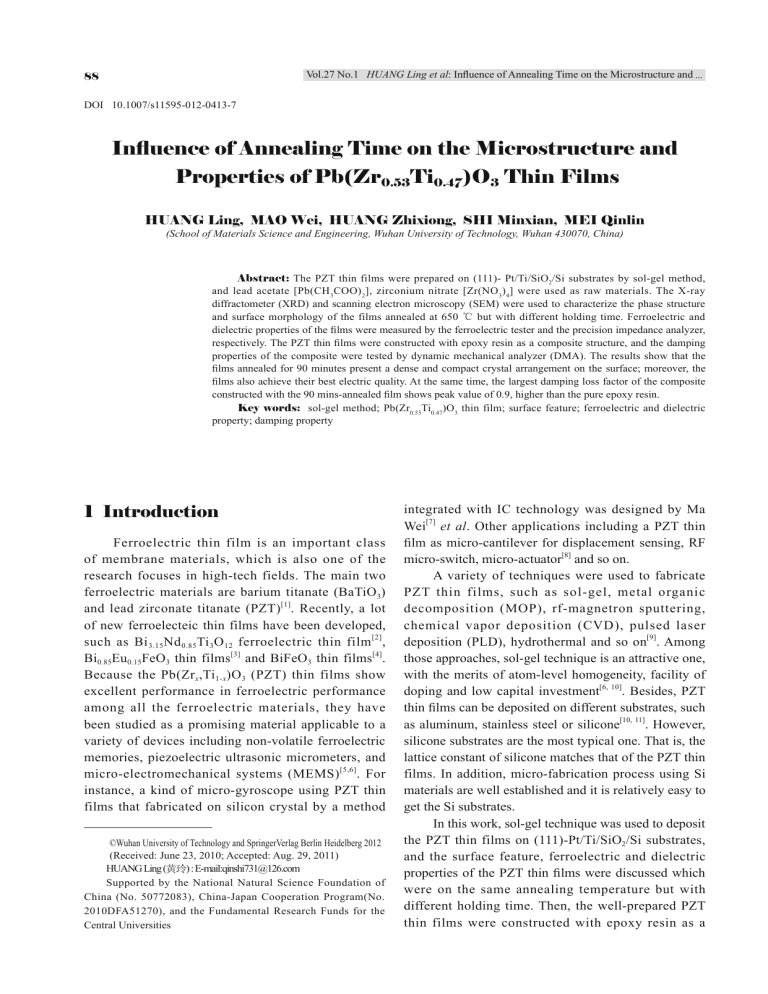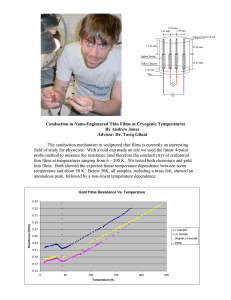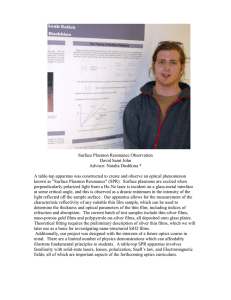
Vol.27 No.1 HUANG Ling et al: Influence of Annealing Time on the Microstructure and ...
88
DOI 10.1007/s11595-012-0413-7
Influence of Annealing Time on the Microstructure and
Properties of Pb(Zr0.53Ti0.47)O3 Thin Films
HUANG Ling, MAO Wei, HUANG Zhixiong, SHI Minxian, MEI Qinlin
(School of Materials Science and Engineering, Wuhan University of Technology, Wuhan 430070, China)
Abstract: The PZT thin films were prepared on (111)- Pt/Ti/SiO2/Si substrates by sol-gel method,
and lead acetate [Pb(CH 3COO) 2], zirconium nitrate [Zr(NO 3) 4] were used as raw materials. The X-ray
diffractometer (XRD) and scanning electron microscopy (SEM) were used to characterize the phase structure
and surface morphology of the films annealed at 650 ℃ but with different holding time. Ferroelectric and
dielectric properties of the films were measured by the ferroelectric tester and the precision impedance analyzer,
respectively. The PZT thin films were constructed with epoxy resin as a composite structure, and the damping
properties of the composite were tested by dynamic mechanical analyzer (DMA). The results show that the
films annealed for 90 minutes present a dense and compact crystal arrangement on the surface; moreover, the
films also achieve their best electric quality. At the same time, the largest damping loss factor of the composite
constructed with the 90 mins-annealed film shows peak value of 0.9, higher than the pure epoxy resin.
Key words: sol-gel method; Pb(Zr0.53Ti0.47)O3 thin film; surface feature; ferroelectric and dielectric
property; damping property
1 Introduction
Ferroelectric thin film is an important class
of membrane materials, which is also one of the
research focuses in high-tech fields. The main two
ferroelectric materials are barium titanate (BaTiO3)
and lead zirconate titanate (PZT)[1]. Recently, a lot
of new ferroelecteic thin films have been developed,
such as Bi 3.15Nd 0.85Ti 3O 12 ferroelectric thin film [2],
Bi0.85Eu0.15FeO3 thin films[3] and BiFeO3 thin films[4].
Because the Pb(Zr x,Ti 1-x)O 3 (PZT) thin films show
excellent performance in ferroelectric performance
among all the ferroelectric materials, they have
been studied as a promising material applicable to a
variety of devices including non-volatile ferroelectric
memories, piezoelectric ultrasonic micrometers, and
micro-electromechanical systems (MEMS) [5,6]. For
instance, a kind of micro-gyroscope using PZT thin
films that fabricated on silicon crystal by a method
©Wuhan University of Technology and SpringerVerlag Berlin Heidelberg 2012
(Received: June 23, 2010; Accepted: Aug. 29, 2011)
HUANG Ling (黄玲) : E-mail:qinshi731@126.com
Supported by the National Natural Science Foundation of
China (No. 50772083), China-Japan Cooperation Program(No.
2010DFA51270), and the Fundamental Research Funds for the
Central Universities
integrated with IC technology was designed by Ma
Wei[7] et al. Other applications including a PZT thin
film as micro-cantilever for displacement sensing, RF
micro-switch, micro-actuator[8] and so on.
A variety of techniques were used to fabricate
PZT thin films, such as sol-gel, metal organic
decomposition (MOP), rf-magnetron sputtering,
chemical vapor deposition (CVD), pulsed laser
deposition (PLD), hydrothermal and so on[9]. Among
those approaches, sol-gel technique is an attractive one,
with the merits of atom-level homogeneity, facility of
doping and low capital investment[6, 10]. Besides, PZT
thin films can be deposited on different substrates, such
as aluminum, stainless steel or silicone[10, 11]. However,
silicone substrates are the most typical one. That is, the
lattice constant of silicone matches that of the PZT thin
films. In addition, micro-fabrication process using Si
materials are well established and it is relatively easy to
get the Si substrates.
In this work, sol-gel technique was used to deposit
the PZT thin films on (111)-Pt/Ti/SiO2/Si substrates,
and the surface feature, ferroelectric and dielectric
properties of the PZT thin films were discussed which
were on the same annealing temperature but with
different holding time. Then, the well-prepared PZT
thin films were constructed with epoxy resin as a
Journal of Wuhan University of
Technology-Mater. Sci. Ed.
composite structure, and the damping properties of the
composite were tested and analyzed, which was just the
creative aspect of this paper.
2 Experimental
2.1 Preparation of PZT thin films
Lead acetate [Pb(CH3COO)2], zirconium nitrate
[Zr(NO 3 ) 4 ], and TEOF [Ti(CH 9 O) 4 ] were used as
raw materials of sol-gel method to prepare the PZT
precursor solution. At the same time, ethylene glycol
monomethyl ether (EM) and acetylacetone served as
the solvent and the chemical modifier, respectively.
The performance of Pb(Zrx,Ti1-x)O3 thin films changes
according to different values of x. However, there
is a consensus that, the Pb(Zr x,Ti 1-x)O 3 thin films
show best ferroelectric, dielectric and the highest
volume resistivity when a composition is near the
morphotoropic phase boundary (MPB) of Zr/Ti =
53/47, when x is 0.53[6, 10, 12, 13]. In order to compensate
for the lead evaporation, excess 10% lead acetate is
necessary.
After the precursor solution is ready, PZT films
can be spin-coated on (111)-Pt/Ti/SiO2/Si substrates at
3 000 rpm for 20 s, and subsequently given a pyrolysis
treatment at 400 ℃ for 10 min to get amorphous films.
Repeat above processes to get fixed thickness films
we want. Next, these fixed films were annealed at 650
℃ and held for 30 mins, 60 mins, 90 mins, 120 mins
and 150 mins, respectively, by conventional thermal
annealing (CTA) to obtain single-annealed PZT thin
films [12, 13]. The whole work was carried out in the
fuming hood.
2.2 Preparation of composites
The well-prepared PZT thin films were cut to
strips, whose size is 15 mm×4 mm. Then, the ready-cut
film strips were put upward on the mold and a certain
thickness epoxy resin were cast into the films to form a
three-layered composite structure. The composite were
cured for 24 hours at room temperature, and post-cured
for 2 hours at 80 ℃ [12]. The other side of the strips was
mixed with epoxy resin in the same way. Finally, a
four-layered composite structure was formed.
2.3 Characterization
The crystalline texture and phase analysis of the
PZT thin films were determined by X-ray diffraction on
a Rigaku Ultima Ⅱ diffractometer with the scan angle
carried out from 10° to 60°. Simultaneously, the surface
morphology of the films were observed using SEM
(S-3400N, Japan).
Feb.2012
89
The ferroelectric P-E hysteresis loops were
measured using the Radiant Precision Workstation
ferroelectric test system, and the positive and negative
coercive electric fields are estimated to be -600 kV/
cm and 600 kV/cm, respectively. And the dielectric
properties of the films were measured by an HP4294A
precision impedance analyzer. Above characterizations
were all operated at room temperature.
The damping properties of the composites could
be tested by dynamic mechanical analyzer (J DiamondDMA). The test temperature rose from 25 ℃ to 180 ℃,
with the heating rate and prestess being 2 ℃/min and
100 mN, respectively.
3 Results and discussion
3.1 Crystalline and surface morphology
XRD spectrum of the PZT thin films annealed at
650 ℃ but held for different time is shown in Fig. 1.
In the figure, there are (001)/(100), (101)/(110), (111),
(002)/(200) PZT, and there is not any heterogeneous
phases such as a pyrochlore structure. It means that the
PZT films have a polycrystalline perovskite structure
regardless of how long the films had been annealed. In
addition, (111) PZT becomes more obvious when the
annealing time reaches 90 mins, but there is no much
difference after the annealing time exceeding 90 mins.
The reason may be that the crystal grains grow up as
the annealing time increased from 30 mins to 90 mins,
but the growth becomes very small so that the change
cannot be seen from the spectrum.
Fig.2 shows SEM images of the surface
morphology of the PZT films annealed at 650 ℃ but
held for different time. It is obvious that the 90 minsannealed films exhibit a dense and uniform surface
morphology. It also can be seen that longer annealing
time is good for the growth of the grains, so the grains
of the films annealing for 120 mins or 150 mins are
bigger than that of 90 mins-annealed films. When the
90
Vol.27 No.1 HUANG Ling et al: Influence of Annealing Time on the Microstructure and ...
annealing time is over 90 mins, there are more and
more obvious defects and cracks on the surface of the
films. The result is consistent with the previous XRD
analysis.
3.2 Electric properties
The PZT films attract so much attention just
because they have good electric properties, including
ferroelectric and dielectric properties. The typical
P-E hysteresis loop of the PZT thin films is shown in
Fig.3. The loop gives a relatively good symmetry. The
remnant polarization (2Pr) and the coercive field (2Ec)
of the PZT films annealed for different holding time are
listed in Table 1. It can be seen that, when the annealing
time is 90 min, the 2Pr and 2Ec obtained from the table
are 43.4 μC/cm2 and 162.8 kV/cm, respectively. That
is, the 2Pr reaches the maximum and the 2Ec gets to
the minimum, and the films give their best ferroelectric
property. It is speculated that longer annealing time is
good for the crystallization of the films, and ameliorate
their ferroelectric; however, if the annealing time is
too long, lead evaporation will bring on the chemical
composition away from the stoichiometic optimum and
a reduction in ferroelectric activity[14].
Fig.4 shows the relationship between annealing
time and dielectric constant (ε) or dielectric loss (tanδ)
at 1 MHz. The picture shows that ε and tanδ basically
have no too much fluctuation at first, but there is a
turning point when the annealing time is over 90 mins:
the value of ε starts to decline, and the value of tanδ
rises sharply. The tanδ keeps at about 0.027 when the
annealing time changes from 30 mins to 90 mins. The
result indicates that annealing time cannot ameliorate
the dielectric of the films; on the contrary, the dielectric
property may drop due to more and more defects and
cracks occurring on the surface of the PZT films.
3.3 Damping properties
Epoxy resin is a kind of polymer materials,
which owns good viscoelastic so that it can be used as
damping materials[15]. Now, the PZT thin films were
constructed with epoxy resin, to enhance the damping
property of the composites. The damping loss factor
and the largest damping loss factor of composites with
the PZT thin films annealed at 650 ℃ for different
holding time are shown in Fig.5 and Fig.6, respectively.
It can be seen that, the peak value of damping
loss factor (tanβmax) of composites are all more than
0.83, higher than the pure epoxy resin in Fig.6. And the
maximum of composites reach 0.9 when the annealing
Journal of Wuhan University of
Technology-Mater. Sci. Ed.
time is 90 mins. But, the damping temperature range
of composites with the PZT thin films annealed for any
holding time are almost the same in Fig.5. The reason is
that much vibration energy could be dissipated through
the PZT films due to its good electric properties.
However, the contribution to the damping temperature
range still comes from epoxy resin.
[2]
Feb.2012
91
FU Chengju, HUANG Zhixiong, LI Jie, et al. Preparation of
Bi 3.15Nd 0.85Ti 3O 12 Ferroelectric Thin Films by Sol-Gel Method[J].
Piezoelectric & Acoustooptics, 2010, 32 (2): 274-276
[3]
FU Chengju, HUANG Zhixiong, LI Jie, et al. Preparation and
Multiferroic Properties of Bi0.85Eu0.15FeO3 Thin Films Prepared by Solgel Method[J]. Materials Review, 2010, 24 (2): 17-19
[4] WANG Xiuzhang, YAN Bowu, DAI Zhigao, et al. Effect of Annealing
Temperature on the Ferroelectric Properties of BiFeO3 Thin Films
Prepared by Sol-gel Process[J]. Journal of Wuhan University of
Technology-Mater. Sci. Ed., 2010, 25 (3): 384-387
[5]
ZHANG Hongfang, SHE Zhengguo. A Study on the Preparation of
PZT Thin Film Sol-Gel Processing[J]. Journal of Jiangsu University,
2002, 23 (2): 83-87
[6]
F. Yang, W D Fei, Q Sun. Highly (100)-textured Pb(Zr0.52Ti0.48)O3
Film Derived from a Modified Sol-gel Technique Using Inorganic
Zirconium Precursor[J]. Journal of Materials Processing Technology,
2009, 209: 220-224
[7]
MA Wei, RICHY LEE Shi-wei, YU Ji-lin. Design of Microguroscope
with PZT Thin Film for Actuating and Sensing[J]. Piezoelectric &
Acoustoophics, 2001, 23 (1): 18-21
4 Conclusions
The PZT thin films with a Zr/Ti=53:47 was
deposited on (111)-Pt/Ti/SiO2/Si substrates by sol-gel
technique and conventional thermal annealing, whose
annealing time was from 30 mins to 150 mins; and
the influence of the annealing time on the films was
discussed. Through a variety of characterization, the
films reveal their best properties when the annealing
time is 90 mins. In that case, the surface of the films is
dense and uniform, and the films have a polycrystalline
perovskite structure and excellent electric properties:
the 2P r and 2E c are 43.4 μC/cm 2 and 162.8 kV/cm,
respectively. Then, the films were cut to strips and
constructed with epoxy resin to form a composite
structure. The damping property of the composites is
tested by dynamic mechanical analyzer, and the peak
value of tanβ max is 0.9 when the annealing time is
also 90 mins. The peak value of damping loss factor
is higher than that of the pure epoxy resin, possibly
because much vibration energy could be dissipated
through the PZT films.
[8]
QIU Cheng-jun, CAO Mao-sheng, MENG Li-na, et al.Process Research
of Microactuator with PZT Prepared by Sol-gel[J]. Journal of Yunnan
University, 2005, 27 (3A): 325-329
[9]
Li Junhong, Wang Chenghao, Huang Xin, et al. Fabrication of SiliconBased PZT Films Compoatible with MEMS[J]. Chinese Journal of
Semiconductors, 2006, 27 (10): 1 776-1 780
[10] Takaaki Suzuki, Isaku Kanno, Jacob J Loverich, et al. Characterization
of Pb(Zr,Ti)O3 Thin Films Deposited on Stainless Steel Substrates by
RF-magnetron Sputtering for MEMS Applications[J]. Sensors and
Actuators A, 2006, 125: 382-386
[11] Eisuke Tokumistsu, Taka-aki Miyasako, Masaru Senoo. Impact of Low
Pressure Consolidation Annealing on Electrical Properties of Sol-gel
Derived Pb(Zr,Ti)O3 Films[J]. Journal of European Ceramic Society,
2005, 25: 2 277-2 280
[12]
MAO Wei, QIN Yan, HUANG Zhi-xiong, et al. Effect of Annealing
Temperature on the Microstructure and Properties of Pb(Zr0.53Ti0.47)O3
Thin Films[J]. Journal of Functional Materials, 2009, 12 (40): 1 9841 986
[13] Nicolas Ledermann, Paul Muralt, Jacek Boborowski, et al.
{100}-Textured, Piezoelectric Pb(Zrx, Ti1-x)O3 Thin Films for MEMS:
Integration, Deposition and Properties[J]. Sensors and Actuators A,
2003, 105: 162-170
[14] N R Harris, M Hill, R Torah, et al. A Multilayer Thick-film PZT
Actuator for MEMs Applications[J]. Sensors and Actuators A, 2006,
References
132: 311-316
[1] FU Chunlin, PAN Fusheng, CAI Wei, et al. History and Current Situation
[15] HUANG Zhixiong, SHI Minxian, YANG Guorui, et al. Research
of Ferroelectrics[J]. Journal of Chongqing University of Science and
Program of Epoxy Resin Based Damping Composite Materials[J].
Technology, 2008, 10 (6): 55-57
ZHAN JIE, 2007, 28 (1): 47-49





